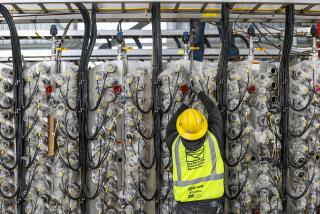Cleanup of MTBE Begins at Base
- Share via
PORT HUENEME — The Navy began a chemical cleanup Friday that it hopes will eventually lead to a blueprint for other communities across the nation to follow when removing the contaminant MTBE from water sources.
The Naval Construction Battalion Center is a test site for various methods of controlling the fast-moving pollutant that was intended to help fuel burn cleaner but has also dirtied ground water. The naval base was chosen because it has a large pool of MTBE beneath its grounds, making it a ready-made laboratory for experimenting with ways to rid water of the chemical, officials said.
Although methyl tertiary butyl ether has not been proven a health hazard, it has a strong turpentine-like taste and odor. The Environmental Protection Agency has said MTBE may be a carcinogen, but testing results have been inconclusive.
Scientists believe the most effective procedure to clean it up is to create a “bio-barrier” of microorganisms that eat MTBE, breaking it down into carbon dioxide and water.
The $1-million project was activated Friday after a month of construction and pretesting. Hundreds of pipes pierced the asphalt at the base, pumping a delicate balance of air and pure oxygen into the soil.
After a month, bacteria will be added to help digest the MTBE.
Port Hueneme’s contaminated area is about one mile long, and is growing as fast as one foot per day. It has been spreading since 11,000 gallons of gasoline began leaking from underground tanks in 1985.
The faulty tanks have since been replaced, but the chemical was already on its way into the water table. MTBE was detected by the Navy in 1992, but it was said to pose no risk to people or the environment.
“The reason we haven’t done all this before is that the health effects of MTBE are still debated . . . and until recently people believed [MTBE] wouldn’t degrade anyway,” said Paul Johnson, the principal scientist with the project.
But now 49 of 50 states are said to have MTBE-contaminated water, and the pollutant has led to the shutdown of much of the domestic water supply for Santa Monica and South Lake Tahoe. Gov. Gray Davis ordered it banned in the state by 2002 and other states have moved to do the same.
Base spokeswoman Linda Wadley emphasized that despite the relatively large size of the contaminated area, there is no reason for alarm in Port Hueneme.
“This is fully confined and there are no pathways [for it] to the public,” she said.
The contaminated water is seven to 20 feet below the base, creeping from the inland area toward the sea. Scientists say the contaminated water will filter through 440 wells of pipes that willpump oxygen and, soon, bacteria-eating MTBE into the ground in order to clean up the water.
The project is being undertaken by the Naval Facilities Engineering Service Center and Arizona State University. At Friday’s ribbon-cutting ceremony, Johnson said the program will continue for three years.
“The purpose of this is that when we get done, we will have design guidelines and a manual that can be used in other sites,” he said.
More to Read
Sign up for Essential California
The most important California stories and recommendations in your inbox every morning.
You may occasionally receive promotional content from the Los Angeles Times.













